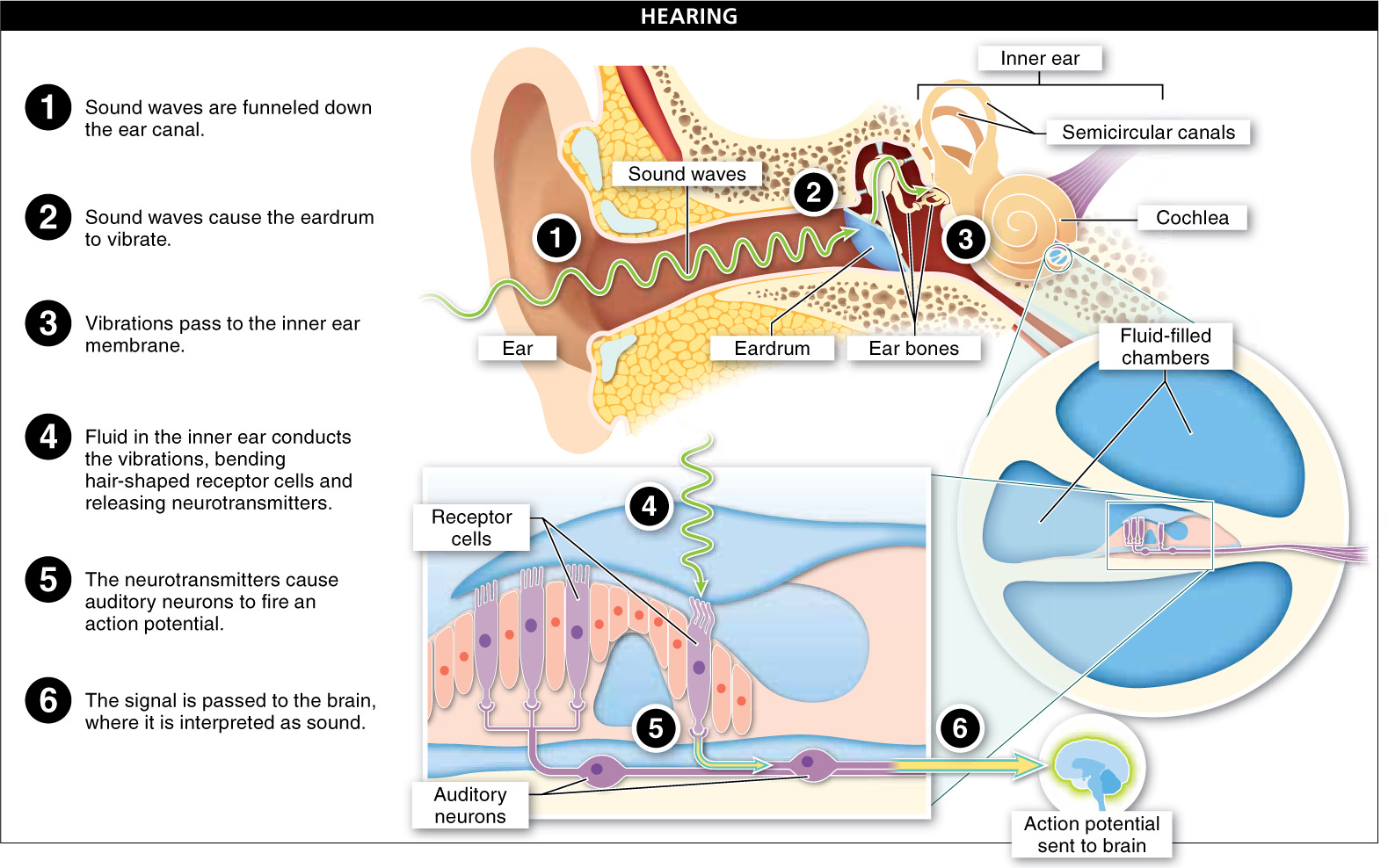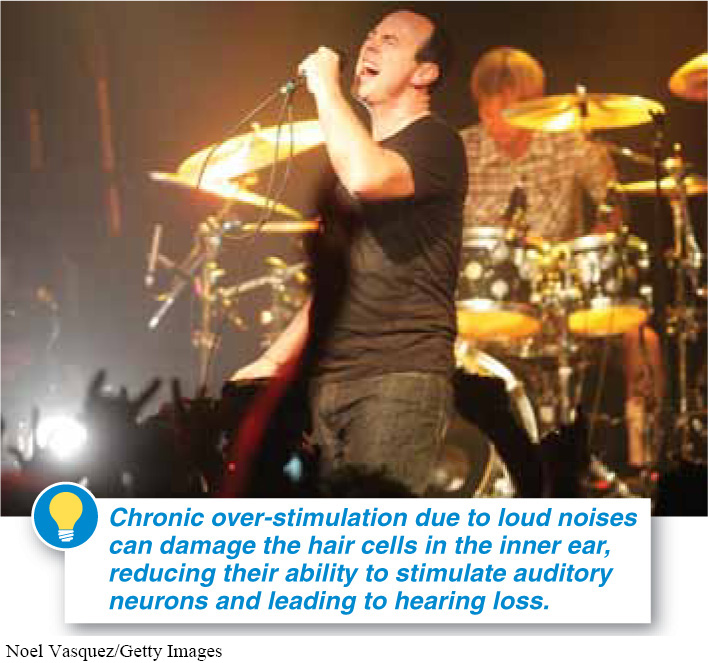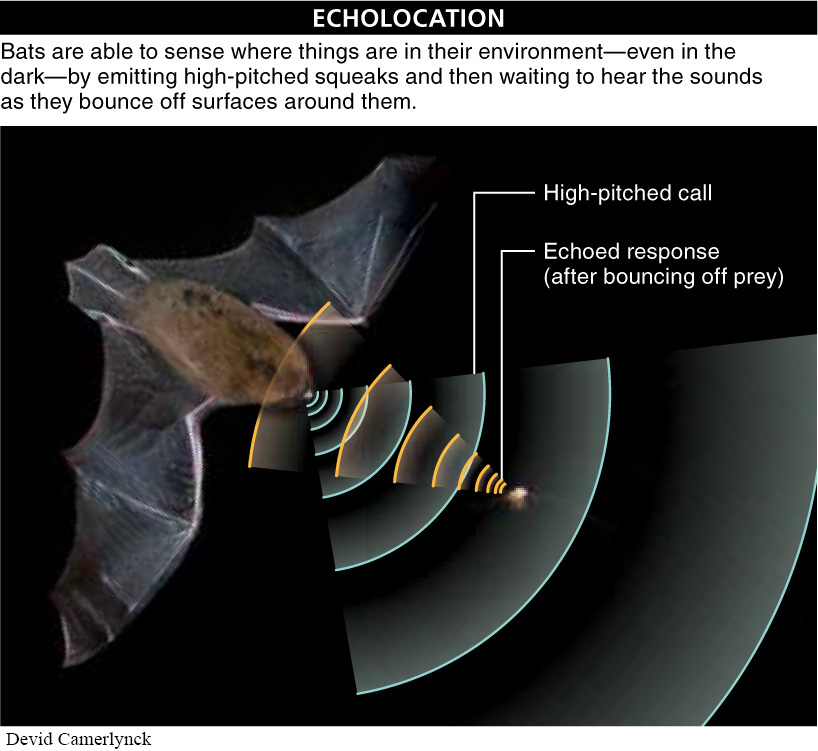23.12: Hearing: sound waves are collected by the ears and stimulate auditory neurons.
Hearing is yet another variation on a theme. As with the previous senses described, something in the external world stimulates modified neurons, and the stimulation initiates an action potential that passes along a series of neurons until it reaches the brain. In this case, the stimuli from the outside world are sound waves, tiny fluctuations in air pressure, collected and amplified by the ears, which then pass information to the brain. While tastes and smells are detected by chemoreceptors and sight is made possible by photoreceptors, hearing is a result of the stimulation of mechanoreceptors, specialized neurons with receptors that respond to mechanical pressure.
Although the details of how hearing works vary across different species, a general, six-

939
- 1. The outer part of the ear collects sound waves and, because of its shape, funnels them down the ear canal, a channel that conducts sound waves.
- 2. At the end of the ear canal, the sound waves bang into the eardrum—a thin membrane that divides the outer ear from the middle portion of the ear—
causing it to vibrate. - 3. Small bones on the other (inner) side of the eardrum pass the vibrations on to the inner ear membrane.
- 4. The vibrations are conducted by fluid inside the inner ear, which consists of fluid-
filled canals in the bones of the skull. The semicircular canals function in balance, and the coiled cochlea is involved in hearing. This fluid movement bends hair- shaped receptor cells, which release neurotransmitters. (The more vigorous their bending— in response to stronger sound waves— the greater the amount of neurotransmitter released.) - 5. Auditory neurons respond to the neurotransmitters released by the hair cells by firing an action potential.
- 6. The signal continues along a path of neurons to the brain, where it is interpreted as sound.
The fluid in the semicircular canals of the inner ear also acts like an inner motion detector, telling your body about its orientation, speed, and direction. It’s not a foolproof system, though. Sitting in an IMAX theater watching a movie filmed from the seat of a roller coaster, your eyes tell your brain that you are moving, while your inner ear senses no motion at all. The conflicting signals can confuse your brain and lead to feelings of nausea. Some people experience similar effects when playing certain videogames.
Q
Question 23.9
How can you get motion sickness without moving at all?
Long-
Q
Question 23.10
How can loud music lead to hearing loss?
940

Are ears necessary for hearing? Not really. Most insects, for example, don’t have ears but still can hear a wide range of sounds, often with even greater sensitivity than humans. They do it with delicate hairs on their antennae, or on other parts of the body, that bend slightly in response to sound waves, much like the inner-
Among the mammals, bats have a unique system for hearing, called echolocation. Most bats spend nearly all of their time in the dark, and such a sensitive call-

TAKE-HOME MESSAGE 23.12
Hearing occurs when sound waves cause the eardrum to vibrate, moving tiny bones that pass on the vibrations to the inner ear, where the vibrations bend hair cells and thus trigger a pattern of action potentials that varies according to the wavelengths of the sound. This is interpreted by the brain as sound.
We've learned that tastes and smells are detected by chemoreceptors, and the sense of sight is made possible by photoreceptors. How does hearing function? Is the mechanism the same for all animal species?